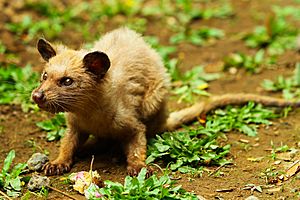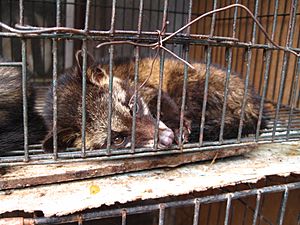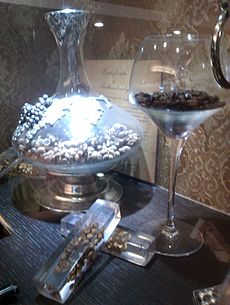Kopi luwak facts for kids
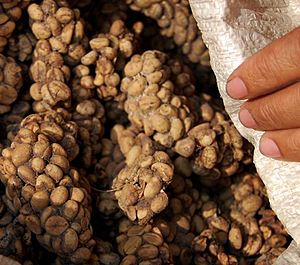 |
|
| Alternative names | Indonesian pronunciation: [ˈkopi ˈlu.aʔ] |
|---|---|
| Place of origin | Indonesia |
| Main ingredients | Coffea arabica |
Kopi luwak is a coffee that consists of partially digested coffee cherries, which have been eaten and defecated by the Asian palm civet (Paradoxurus hermaphroditus). It is also called civet coffee. The cherries are fermented as they pass through a civet's intestines, and after being defecated with other fecal matter, they are collected. Asian palm civets are increasingly caught in the wild and traded for this purpose.
Kopi luwak is produced mainly on the Indonesian islands of Sumatra, Java, Bali, Sulawesi, and in East Timor. It is also widely gathered in the forest or produced in farms in the islands of the Philippines, where the product is called kape motit in the Cordillera region, kapé alamíd in Tagalog areas, kapé melô or kapé musang in Mindanao, and kahawa kubing in the Sulu Archipelago. Weasel coffee is a loose English translation of its Vietnamese name cà phê Chồn.
Producers of the coffee beans argue that the process may improve coffee through two mechanisms: selection – civets choosing to eat only certain cherries, and digestion – biological or chemical mechanisms in the animals' digestive tracts altering the composition of the coffee cherries.
The traditional method of collecting feces from wild Asian palm civets has given way to an intensive farming method, in which the palm civets are kept in battery cages and are force-fed the cherries. This method of production has raised ethical concerns about the treatment of civets and the conditions they are made to live in, which include isolation, poor diet, small cages, and a high mortality rate.
Although kopi luwak is a form of processing rather than a variety of coffee, it has been called one of the most expensive coffees in the world, with retail prices reaching US$100 per kilogram for farmed beans and US$1,300 per kilogram for wild-collected beans.
Contents
History
The origin of kopi luwak is closely connected to the history of coffee production in Indonesia; Dutch colonialists established coffee plantations in Indonesia and imported beans from Yemen. In the 19th century, farmers in central Java started to brew and drink coffee from excreted beans collected in their plantations.
Production

Kopi luwak is brewed from coffee beans that transversed the gastrointestinal tract of an Asian palm civet, and were thus subjected to a combination of acidic, enzymatic, and fermentation treatment. During digestion, digestive enzymes and gastric juices permeate through the endocarp of coffee cherries and break down storage proteins, yielding shorter peptides. This alters the composition of amino acids and impacts the aroma of the coffee. In the roasting process, the proteins undergo a non-enzymatic Maillard reaction. The palm civet is thought to select the most ripe and flawless coffee cherries. This selection influences the flavour of the coffee, as does the digestive process. The beans begin to germinate by malting, which reduces their bitterness. When performed in nature, or in the wild, these two mechanisms achieve the same goal as selective picking and the wet or washed process of coffee milling: 1) harvesting optimally ripe cherries and 2) mechanically and chemically removing the pulp and skin from the cherry, leaving mainly the seed.
Traditionally, excreted coffee beans were collected directly in plantations and forests. As the international demand for kopi luwak increased, some producers turned to caged production methods to increase yields. In 2014, the annual kopi luwak production was grossly estimated at less than 127 kg. It is produced in Indonesia, East Timor, the Philippines, Thailand, Vietnam and Ethiopia.
Taste
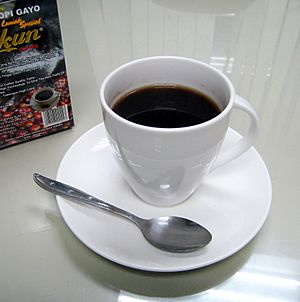
The taste of kopi luwak varies with the type and origin of excreted beans, processing, roasting, aging, and brewing. The ability of the civet to select its berries, and other aspects of the civet's diet and health, like stress levels, may also influence the processing and hence taste.
Within the coffee industry, kopi luwak is widely regarded as a gimmick or novelty item. The Specialty Coffee Association of America (SCAA) states that there is a "general consensus within the industry...it just tastes bad". A coffee professional compared the same beans with and without the kopi luwak process using a rigorous coffee cupping evaluation. He concluded: "it was apparent that luwak coffee sold for the story, not superior quality...Using the SCAA cupping scale, the luwak scored two points below the lowest of the other three coffees. It would appear that the luwak processing diminishes good acidity and flavor and adds smoothness to the body, which is what many people seem to note as a positive to the coffee.” Professional coffee tasters were able to distinguish kopi luwak from other coffee samples, but remarked that it tasted "thin". Some critics claim more generally that kopi luwak is simply bad coffee, purchased for novelty rather than taste. A food writer reviewed kopi luwak available to American consumers and concluded "It tasted just like...Folgers. Stale. Lifeless. Petrified dinosaur droppings steeped in bathtub water. I couldn't finish it."
Imitation
Several commercial processes attempt to replicate the digestive process of the civets without animal involvement. Researchers with the University of Florida have been issued with a patent for one such process. Brooklyn-based food startup Afineur has also developed a patented fermentation technology that reproduces some of the taste aspects of Kopi Luwak while improving coffee bean taste and nutritional profile.
Vietnamese companies sell an imitation kopi luwak, made using an enzyme soak which they claim replicates the civet's digestive process.
Imitation has several motivations. The high price of kopi luwak drives the search for a way to produce kopi luwak in large quantities. Kopi luwak production involves a great deal of labour, whether farmed or wild-gathered. The small production quantity and the labor involved in production contribute to the coffee's high cost. Imitation may be a response to the decrease in the civet population.
Animal welfare
Growing numbers of intensive civet "farms" have been established and are operated in Southeast Asia, confining tens of thousands of animals to live in battery cages and be force-fed. "The conditions are awful, much like battery chickens", said Chris Shepherd, deputy regional director of TRAFFIC in Southeast Asia. "The civets are taken from the wild and have to endure horrific conditions. They fight to stay together but they are separated and have to bear a very poor diet in very small cages. There is a high mortality rate and for some species of civet, there's a real conservation risk. It is spiraling out of control". The trade in palm civets for the production of kopi luwak may constitute a significant threat to wild populations.
In 2013, People for the Ethical Treatment of Animals (PETA) investigators found wild-caught civets on farms in Indonesia and the Philippines. They were deprived of exercise, proper diet, and space. Video footage from the investigation shows abnormal behaviours such as repeated pacing, circling, or biting the bars of their cages. The animals often lose their fur. A BBC investigation revealed similar conditions. Farmers using caged palm civets in north Sumatra confirmed that they supplied kopi luwak beans to exporters whose produce ends up in Europe and Asia. Tony Wild, the coffee executive responsible for bringing kopi luwak to the Western world, has stated he no longer supports using kopi luwak due to animal cruelty and launched a campaign to halt the use of kopi luwak.
Price and availability
Kopi luwak is one of the most expensive coffees in the world, selling for between $220 and $1,100 per kilogram ($100 and $500/lb) in 2010. The price paid to collectors in the Philippines is closer to US$20 per kilogram. The specialty Vietnamese weasel coffee, which is made by collecting coffee beans eaten by wild civets, is sold at US$500 per kilogram. Most customers are Asian, especially those originating from Japan, China, and South Korea.
Some specialty coffee shops sell cups of brewed kopi luwak for US$35–80.
Authenticity and fraud
Investigations by PETA and the BBC found fraud to be rife in the kopi luwak industry, with producers willing to label coffee from caged civets with a "wild sourced" or similar label.
Genuine kopi luwak from wild civets is difficult to purchase in Indonesia and proving it is not fake is very difficult – there is little enforcement regarding use of the name "kopi luwak", and there's even a local cheap coffee brand named "Luwak", which costs under US$3 per kilogram but is occasionally sold online under the guise of real kopi luwak.
Variations
There are reports of a kopi luwak type process occurring naturally with muntjac and birds. Bat coffee is another variation that is in demand. Bats feed on the ripest coffee and fruits and spit out the seeds. These seeds are dried and processed to make coffee with a slight fruity flavor.
In popular culture
In the movie The Bucket List, billionaire health care magnate Edward Cole (played by Jack Nicholson) enjoys drinking kopi luwak, but is unaware of how it is produced. Carter Chambers (Morgan Freeman) explains how civets defecate kopi luwak coffee beans and that its gastric juices give the unique aroma to this coffee.
The Japanese manga series Beastars features an anthropomorphic civet character that produces kopi luwak.
See also
 In Spanish: Café de civeta para niños
In Spanish: Café de civeta para niños


